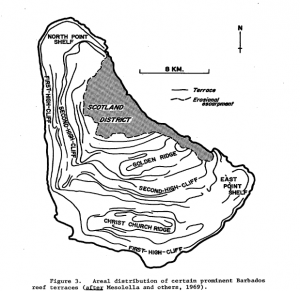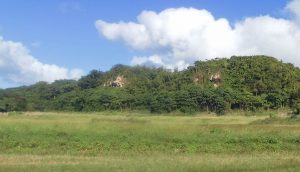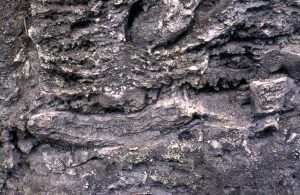From NP James 1971. PhD Thesis, Regional Setting
Noel James conducted his PhD geology research out of the Bellairs Research Institute (Holetown, Barbados) over the same period I was there conducting my PhD studies on tropical seagrasses. We spent many hours talking about coastal processes and how geologists use knowledge of on-going coastal processes to interpret structures and processes of ancient reefs. Noel introduced me to those ancient reefs, so prominent on Barbados. I still refer to his background description of them to refresh my memory…reproduced below.
——–
From:
Late Pleistocene reef limestones, Northern Barbados, W.I.
Noel P. James, 1971. PhD thesis, Department of Earth and Planetary Sciences McGill University
Barbados, the easternmost island of the Caribbean, has, because of its teriarty sediment core and superbly exposed pleistocene limestones, been the subject of several geological investigations…[see 2 examples at bottom of this page].
Barbados can be separated’ into two distinct’. physiographic regions: (1) the Scotland District. underlain by outcropping.Tertiary strata and, (2) the Coral Cap, underlain’ by a succession of terraced Pleistocene limestones which rise to 330 meters above sea level (Fig. 1.

NP James Fig 3. Aerial distribution of certain prominent Barbados reef terraces (after Mesolella and others, 1969.
The Tertiary succession exposed in the Scotland District, and in. various wells is outlined in Table 1. In general.a basal sequence of Lower to Middle Eocene clastics. (Scotland Formation) is overlain by Middle Eocene to Miocene marls and Iimestones (mainly’,Oceanic Formation).
The island appears to have been uplifted more or less contiuously throughouut the Pleistocoene. A coral reef grew arou d the emergent portion during each eustatic high stand of sea level, yielding a Pleistocoene terraced veneer over the core of Tertiary strata, with each terrace representing a single high stand of sea-level (Broecker and others, 1968, Mesolella and others 1969, 1970.)
This interpretation has evolved from radiometric dating of laterally continuous lower terraces on the southern part of the island. The lowest reef terrace is about 83,000 years old and each higher reef terrace is slightly olderthan the one below.
Tow terraces, the “First High Cliff” and “Second High Cliff” (Senn, 1946) (Fig 2,3), have greater relief thn the others and stand out as continuous features around most of the island.
The “First High Cliff” (avg. crest elevation 34 meters/12o ft) is a 127,000 year old reef complex. Two younger terraces, 104,000 and 83,000 years old, lie below it.
Between the first and Second High Cliffs are a series of terraces dated between 170,000 and 230,000 years old.
The Second High Cliff (avg crest elevation 150m/480 ft) and higher reef terraces appear to represent reef complexes formed more than 250,000 years ago.
Original depositional topography of the reef terraces has been modified to varying degrees by subsequent wave abrasion when they were sea cliff amd later by sub-aerial solution.
—–
Zonation of uplifted pleistocene coral reefs on Barbados, West Indies
Mesolella KJ. Science. 1967 May 5;156(3775):638-40.
Abstract: The coral species composition of uplifted Pleistocene reefs on Barbados is very similar to Recent West Indian reefs. Acropora palmata, Acropora cervicornis, and Montastrea annularis are quantitatively the most important of the coral species.
Milankovitch Hypothesis Supported by Precise Dating of Coral Reefs and Deep-Sea Sediments
W.S. broecker et al., 1968. Science 159:3812 pp 297-300
Abstract: Barbados provides a possibly unique opportunity for reconstruction of the times and elevations of late-Pleistocene high stands of the sea. The island appears to be rising from the sea at a uniform rate that is fast enough to separate in elevation coral-reef tracts formed at successive high stands of the sea. Unaltered coral found in the lower terraces enables high-precision Th230: U234 and Pa231: U235 dating. Three distinct high stands of the sea are found about 122,000, 103,000, and 82,000 years ago. New Pa231 and Th230 dates from a deep-sea core also indicate that Ericson’s W-X cold-to-warm climatic change occurred close to 126,000 years ago. These data show a parallelism over the last 150,000 years between changes in Earth’s climate and changes in the summer insolation predicted from cycles in the tilt and precession of Earth’s axis.


